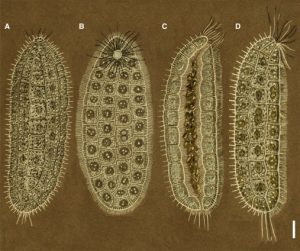Podcast: Play in new window | Download (Duration: 7:01 — 7.8MB)
It’s a tiny mystery animal!
Further reading:
Salinella – what the crap was it?
Some of Frenzel’s drawings of Salinella:

Show transcript:
Welcome to Strange Animals Podcast. I’m your host, Kate Shaw.
Johannes Frenzel was a German zoologist in the 19th century. He worked in Argentina for several years, studying microscopic and near-microscopic animals, and seemed to be a perfectly good scientist who did good work but didn’t make a real splash. But these days he’s remembered for a mystery animal that is still causing controversy in the scientific community.
Frenzel described a strange worm-like animal he named Salinella salve in 1892, and Salinella hasn’t been seen since. According to Frenzel’s description of it, Salinella is very different from every other animal known. It’s so different, in fact, that some scientists think Frenzel just made the whole thing up.
In 1890 or 1891, a colleague gave Frenzel a soil sample reportedly from the salt pans in Argentina. We don’t know exactly where it came from, just that it’s somewhere in the Río Cuarto region. Frenzel put the sample in an aquarium and added water, although apparently some iodine got mixed in too, either on purpose or maybe by accident. Then he forgot all about the sample for a few weeks. It wasn’t covered and Frenzel reported that some dead flies had fallen into the aquarium.
When Frenzel finally got around to examining the sample, he discovered something he had never seen before. No one else had either, before or since. He said it was a worm-like animal about 2 millimeters long, and there wasn’t just one of them. There were quite a few in the sample, some in the soil and some attached to the glass.
When he studied the tiny worms, he discovered they had a very basic, very unusual body plan. It was basically just a tube open at both ends, with a single layer of cells around the interior sac. Each cell was covered with cilia on both the exterior side of the animal and the interior side. Cilia are hair-like structures, and salinella used them to move around, a method of propulsion called ciliary gliding. It didn’t have any organs or even tissues—basically nothing you’d expect even in a very simple animal. It reproduced by splitting down the middle, called transverse fission.
Assuming Frenzel was describing a real animal, and was describing it accurately, this body plan is unlike any other animal known. It’s most similar to what scientists think the body plan was of the precursors to sea sponges. It’s also similar in some ways to a group of parasitic animals called Mesozoa, which are wormlike, very simple, only a few millimeters long at most, and which have an outer layer of ciliated cells. Mesozoans aren’t well understood and most scientists these days think the group is made up of animals that aren’t closely related to each other. Salinella has sometimes been considered a mesozoan, but it’s still not that close of a match.
Frenzel took detailed notes and made careful drawings of Salinella, and compared it to known animals like protozoans. His description of the animal is solid, and he described many other animals in his career that are well-known to scientists today. The main reason some scientists now think Frenzel made Salinella up is because it’s so weird and no one has been able to find it since. Frenzel died in 1897 without ever having the chance to look for more specimens.
In 1963 an American biologist placed Salinella in its own phylum, which he named Monoblastozoa. In the early 2010s, a team of German scientists visited various saline lakes in Argentina and Chile in hopes of finding Salinella specimens, but without luck. The area where the original soil sample came from has mostly been converted to farmland, so if Salinella was restricted to that one spot, it might well be extinct now.
So what happened to the type specimens that Frenzel collected? We don’t know. They vanished sometime between 1891 when Frenzel moved back to Germany from Argentina, and now. It might even be that he couldn’t preserve the specimens, since he reported that every time he tried to preserve one, it disintegrated.
While I was researching this episode, I wondered if Salinella actually came from the flies that reportedly fell into the aquarium. Many parasites evolve to become very simple, like Myxozoa that we talked about in episode 422. But Frenzel observed Salinella apparently eating organic matter in the soil, which isn’t something a fly parasite would or could do.
At this point, unless we can find a living Salinella specimen, there’s no way to know if the animal was real or a figment of Frenzel’s imagination. Some scientists even suggest that Frenzel was mistaken in his description and the real animal might actually be very different from what he described. Considering how detailed and careful Frenzel’s notes and drawings are, and how many other species he described without causing any controversy at all, I think Salinella was a real animal, just a weird one. Let’s hope that one day it’s discovered again so we can learn more about it.
You can find Strange Animals Podcast at strangeanimalspodcast.blubrry.net. That’s blueberry without any E’s. If you have questions, comments, or suggestions for future episodes, email us at strangeanimalspodcast@gmail.com. We also have a Patreon at patreon.com/strangeanimalspodcast if you’d like to support us for as little as one dollar a month and get monthly bonus episodes.
Thanks for listening!